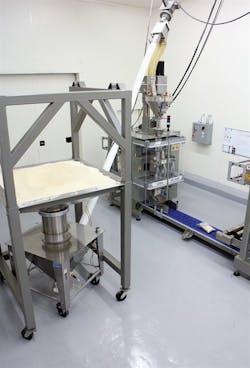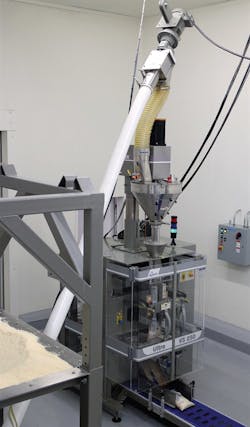Conveyor selection for a batch or continuous processing application is not always as straightforward as it seems. In fact, it almost never is. Moving material consistently – at a rate that is in line with production requirements and in a manner that does not contribute negatively to the plant operating environment, such as dusting or increased maintenance – can be a challenging endeavor for process engineers and procurement personnel.
Conveyors are often misapplied for a variety of reasons, including the desire to keep the number of unique pieces of equipment to a minimum while also adhering to spending limits. While these are indeed critical considerations when selecting a conveyor for a material-handling application, they should not be the primary – or the only – evaluation metrics used.
The most effective way to evaluate all of the best options for batch or continuous processing is to consider each material movement requirement from a blank starting point. Looking at an application with the mindset of “What is the best way to satisfy our material conveying need?” will put processors in a better position to make the right conveyor selection prior to purchase.
With this in mind, there are six key considerations to evaluate during the conveyor selection process:
- Material – What is it and how does it behave?
- Operation – What do you need the conveyor, component or system to do?
- Environment – What environmental factors will affect the design?
- Footprint – What are the space constraints for the new equipment?
- Cost – What is the budget? Is there a payback formula that you must observe?
- History – What doesn’t work? What have you tried before and why was it unsuccessful?
Let’s look at each consideration more closely, beginning with the most complex:
1. Material
Several important characteristics make up the complete material definition. Each should be understood in its entirety. Some of these are dynamic and can influence – or can be influenced by – one or more of the other characteristics, so it is always best to look at them together.
- What is the name of the material? Many materials are known by more than one name. It could be an esoteric or trade name (such as SnoMelt), a generic name (such as salt), or a chemical formula, which is defined by its primary ingredient or ingredients (such as sodium chloride, NaCl).
- What is the form or state in which the material must be handled? Are the solids free-flowing or semi free-flowing, and what is the loose bulk density (lbs/ft3, g/cc, kg/m3)? Loose bulk density is commonly interchanged or confused with specific gravity but should not be, as each are very different. Specific gravity is the weight per given volume of a substance, usually in its most natural, concentrated, unreduced solid form (no air pockets or interstitial spaces between particles). Loose bulk density is the weight per given volume of the material in its reduced, free-flowing or semi free-flowing state.
- What is the composition of the solids? Are they powder, prill, granule, pellet, fiber or flake?
- What is the particle size? Symmetrical solids are usually described in terms of their ability to pass through a screen of a certain size. Asymmetrical solids are usually described in terms of their minimum and maximum geometric dimensions.
- What is the flowability of the material? Flowability is perhaps the most important characteristic to understand about any solid material, yet it lacks a single standardized method of measurement across industrial disciplines. Most often it is defined in somewhat arbitrary terms such as very free flowing, free flowing, average flowability, or sluggish. The angle of repose is also frequently used as an indicator of flowability. It is simply the natural angle or rate of incline that is observed when material is metered from a single discharge point without vibration or any effort to settle or distribute the accumulating mound. If the material is known or suspected to be a challenge because of its flowability, it may be best to send a sample to the equipment supplier for review.
- What is the abrasiveness of the material? Like flowability, abrasiveness lacks a universal standard definition. However, two material factors tend to determine the abrasive quality. First is the material hardness, which is measurable and can be defined using the Mohs scale or Vickers scale. Second is the particle shape. A hard particle having no abrupt edges (a sphere) is less likely to abrade a contact surface than one with sharp edges. Most often, abrasive materials are known to plant personnel, and experience tends to be the most valuable measure. In other words, if a material has been found to erode other plant process equipment, certain parallels can be drawn and educated assumptions made as to the way the material will affect proposed equipment.
- What is the temperature and moisture content of the material? Material temperature is usually defined as a range (minimum to maximum), while moisture content is usually described as a percentage by weight and can provide an important clue as to flowability or cohesiveness.
One of the most common misconceptions with regard to materials and their various handling characteristics is that they can be obtained from Material Safety Data Sheets (MSDS). However, this is rarely the case. As the name implies, the document is a declaration of any health, safety or environmental concerns, and while it may offer some vague clues, it seldom enables a sufficient understanding of the way a material is likely to behave while being handled, stored or processed.
2. Operation
Operation is the requirement of function and performance that a conveyor needs to satisfy. Certain aspects of the operation should include some detail and clarity. Fundamentally, moving material through a process falls into two main categories: conveying and feeding. It is important for processors to understand the difference to ensure the correct conveyor selection.
Conveying is simply moving material (or materials) from one or more pickup points and delivering materials to one or more drop points. The rate at which this is accomplished is usually fixed, and the delivery time, while important, fits comfortably within a minimum and maximum range. Conveyors are most often used as a refilling device for surge hoppers, feeders or process equipment.
Specifying the operation of a conveyor consists of:
- Defining the amount of material that needs to be moved and the window of time in which it must be moved.
- Knowing the demand at each drop point (in cases where there may be multiple discharge points).
- Determining which conditions will initiate or stop a refill, and in the case of multiple discharges, developing suitable logic (or sequence of operation) to establish refill priority so that the process is not inadvertently starved.
- Knowing whether cross-contamination will be an issue (imperative when considering a single conveyor for multiple materials).
Feeding generally is much more time-sensitive and process-critical in terms of the amount of material delivered. Material is normally received from a single source and delivered to a single drop point. Because of the precision with which material needs to be delivered, delivery rates usually vary, either to coincide exactly with a continuous fluctuating demand or slowing to creep up on a batch-complete setpoint.
Defining the operation of a feeder consists of determining whether the feeder will be required to deliver in discrete batches or deliver on a non-stop, rate-controlled basis. If batching, it is important to know the amount that must be delivered, the time in which it must be delivered, and what level of accuracy will suffice (usually defined as a plus-minus percentage of the target weight). It is also important to know the idle or at-rest time of the feeder between batches. If feeding continuously, the rate needs to be defined, as well as the accuracy (usually defined as a plus-minus percentage of the instantaneous rate).
One of the most frequently occurring mistakes with conveyor or feeder sizing comes from confusing material usage with instantaneous demand. For example, while a process may consume 1,000 pounds per hour of material, the conveyor or feeder may need to deliver at a rate that is 12 times higher if the batch needs to be satisfied in five minutes.
Also, most automatic means of feeding and conveying are sized according to the equipment’s volumetric capacity. However, the material demand is most often understood and communicated in terms of its weight. Therefore, a reliable value for the bulk density is necessary in order to calculate the volumetric requirement so that the equipment can be properly sized.
3. Environment
A number of environmental factors must be considered in the proper selection of equipment. Some of these may combine with material characteristics to cause or exacerbate handling concerns, while others may necessitate added health and safety countermeasures.
Some environmental factors include:
- Open sources of ignition
- The potential for a flammable or explosive atmosphere
- Corrosive vapor
- High humidity
- Temperature
- Vibration
- Pressure or vacuum (at inlet, discharge or both)
4. Footprint
The decision between one conveyor and another often comes down to envelope – how much room is available to install the equipment or device? This seems to go without saying, yet it is one of the pieces of information that is most frequently omitted from inquiries.
When considering new equipment, particularly when some portions of the system already exist, always be sure to consider the following:
- What will feed the new equipment and what is the discharge elevation of the upstream equipment?
- What will the new equipment discharge into and what is the inlet elevation of the downstream equipment?
- What is the centerline distance between the proposed inlet and discharge?
- Is the proposed route in a straight line or must it turn a corner or change elevation more than once to avoid an existing structure?
- How much width/depth is available to accommodate the new device or equipment?
- What is the ceiling height?
- Are there any other layout considerations, such as the need to temporarily locate pallets of material or allow maneuvering room for a fork truck?
5. Cost
There is no denying the role cost plays in the feasibility of every project. Understandably, the justification formula is different from one business to the next. Some companies prioritize the long-term cost of ownership in their justification calculation – focusing more on reliability, reduced energy consumption and maintenance – while others focus more on the initial investment. When inquiring about potential solutions, it is in the customer’s best interest to discuss cost with potential suppliers as soon as possible to determine the financial feasibility of a proposed conveying solution. Considering how lean some companies run and how busy everyone is, it can save precious time and energy to have some of this dialogue up-front.
6. History
When replacing existing equipment, the importance of service history cannot be overemphasized. Where reliability has been an issue, understanding the difficulties can provide important clues that lead to suitable countermeasures. Simply changing brand names is no guarantee that you will end up with a more reliable, longer-lasting piece of equipment. It is far better to provide details about service history and ask the vendor to explain how the proposed conveying solution will provide a more satisfactory result.
Conclusion
The proper selection and sizing of a conveyor is critical to successfully meeting production goals in a batch or continuous processing application. The number of key factors that should be considered when choosing a conveyor can be daunting. Taking the time to understand these factors up-front and gather the most accurate data possible related to each component – ideally in partnership with a trusted, experienced supplier – will help you select the best conveying technology for your specific needs and bring the greatest return on your investment.
Joe Zerbel is a senior project manager for Hapman and has more than 25 years of mechanical conveying design and application experience. He may be reached at [email protected]. Hapman is a global leader in the design and manufacture of equipment and systems for bulk material handling.





